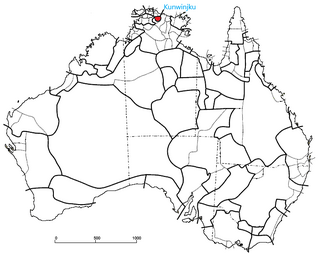Practices
Baldwin Spencer classifies them with many other contiguous tribes in that area:-
To the same group of tribes belong, apparently, the Koarnbut, Quiradara, Norweilemil, Punuurlu, Kumertuo, Geimbio, Malanji, and, possibly, the Larakia. These, together with the Iwaldji, Kakadu, and the Melville and Bathurst Islanders, form a group of tribes sharply marked off, not only by the absence of class organisation, but by the fact that their initiation ceremonies are distinguished by the absence of both circumcision and subincision.
He also adds that, like the others, they do not appear to have used bullroarers.
Airiman were an Indigenous Australian tribe from Australia's Northern Territory.
The Amurdak, people, also written Amarak and Ngamarak, are an indigenous Australian people of the Cobourg Peninsula in the Northern Territory.

The Kunwinjku people are an Australian Aboriginal people, one of several groups within the Bininj people, who live around West Arnhem Land to the east of Darwin, Northern Territory. Kunwinjku people generally refer to themselves as "Bininj" in much the same way that Yolŋu people refer to themselves as "Yolŋu".
The Binbinga, also pronounced Binbinka, are an Indigenous Australian people of the Northern Territory of Australia.
The Garrwa people, also spelt Karawa and Garawa, are an Aboriginal Australian people living in the Northern Territory, whose traditional lands extended from east of the McArthur River at Borroloola to Doomadgee and the Nicholson River in Queensland.
The Djowei are an indigenous Australian people of the Northern Territory.
The Awarai (Warray) are an indigenous Australian people of the Northern Territory.
The Yukul, also written Jukul, were an indigenous Australian people of the Northern Territory.
The Gajirrawoong people, also written Gadjerong, Gajerrong and other variations, are an Aboriginal Australian people of the Northern Territory, most of whom now live in north-eastern Western Australia.
The Tjial were an indigenous Australian people of the Northern Territory who are now extinct.
The Widi were an Aboriginal Australian people of the Mid West region of Western Australia.
The Ngarinman or Ngarinyman people are an Aboriginal Australian people of the Northern Territory who spoke the Ngarinyman language.

The Arabana, also known as the Ngarabana, are an Aboriginal Australian people of South Australia.
The Wilingura otherwise known as the Wilangarra, were an indigenous Australian people of the Northern Territory.
The Watta were an indigenous Australian people of the Northern Territory.
The Iwaidja are an Indigenous Australian people of the Northern Territory.
The Gaagudju, also known as the Kakadu, are an Aboriginal Australian people of the Northern Territory. There are four clans, being the Bunitj or Bunidj, the Djindibi, and two Mirarr clans. Three languages are spoken among the Mirarr or Mirrar clan: the majority speak Kundjeyhmi, while others speak Gaagudju and others another language.
The Gudanji, otherwise known as the Kotandji or Ngandji, are an indigenous Australian people of the Northern Territory.
The Ngormburr, also known as Murumburr and other variants, are an Aboriginal Australian people of the Northern Territory.
The Limilngan, also known by the exonym Minitja and Buneidja, are an Aboriginal Australian people of the Northern Territory. Earlier ethnologists such as Norman Tindale referred to the group as Puneitja or variants of that spelling.
This page is based on this
Wikipedia article Text is available under the
CC BY-SA 4.0 license; additional terms may apply.
Images, videos and audio are available under their respective licenses.

